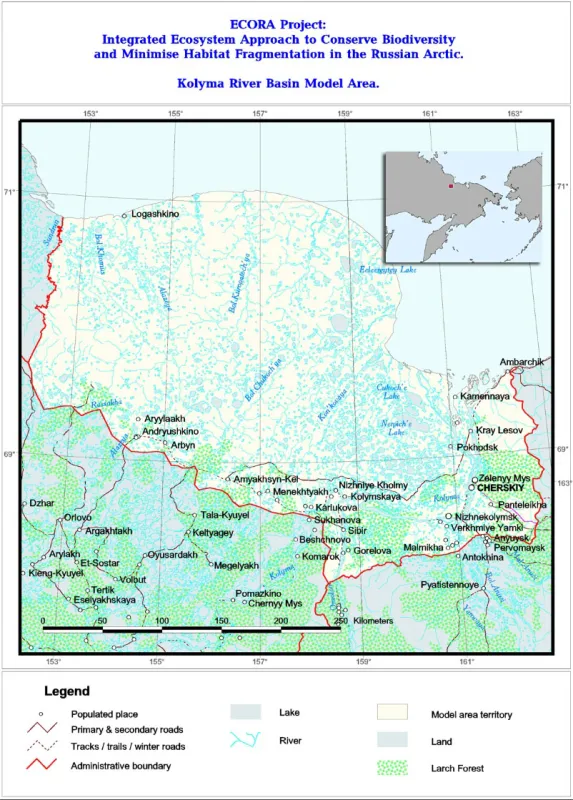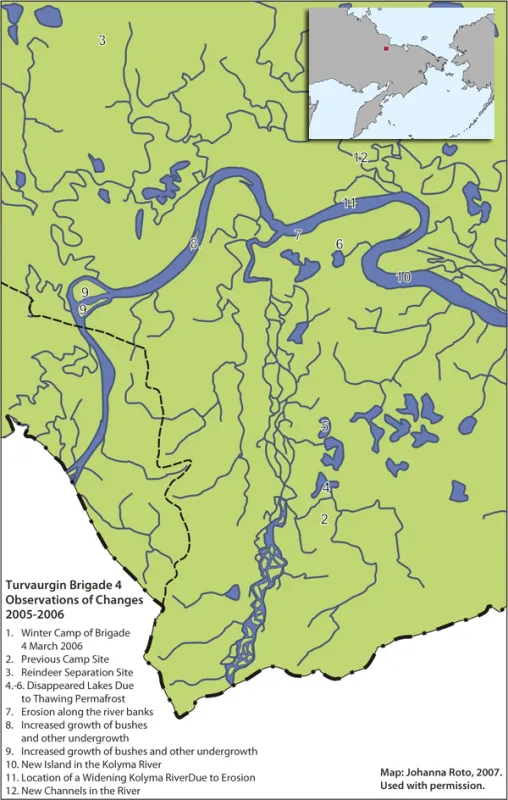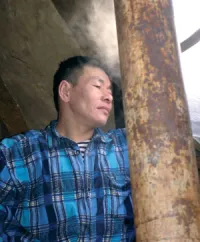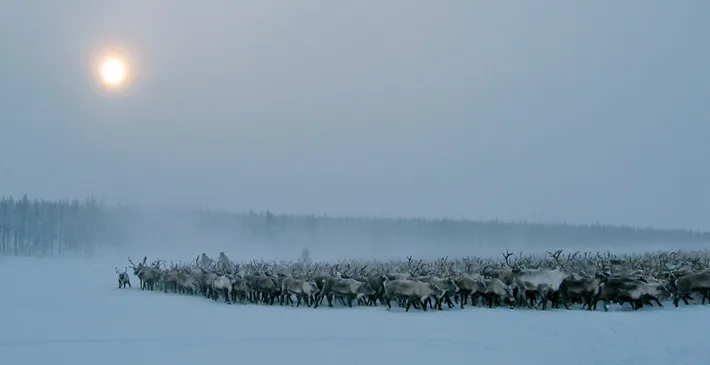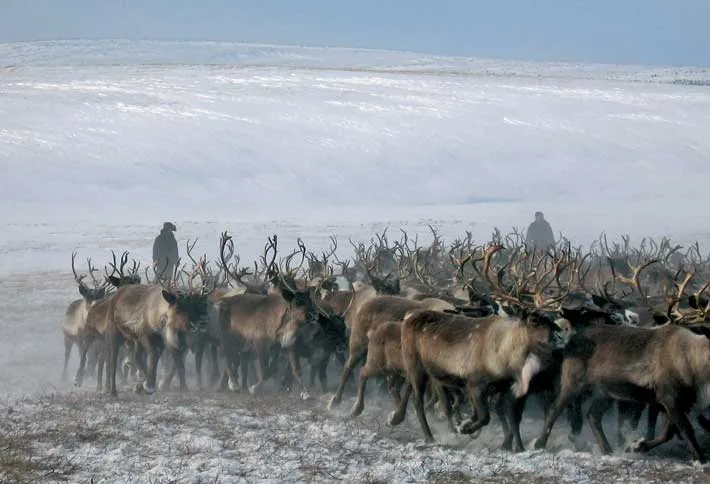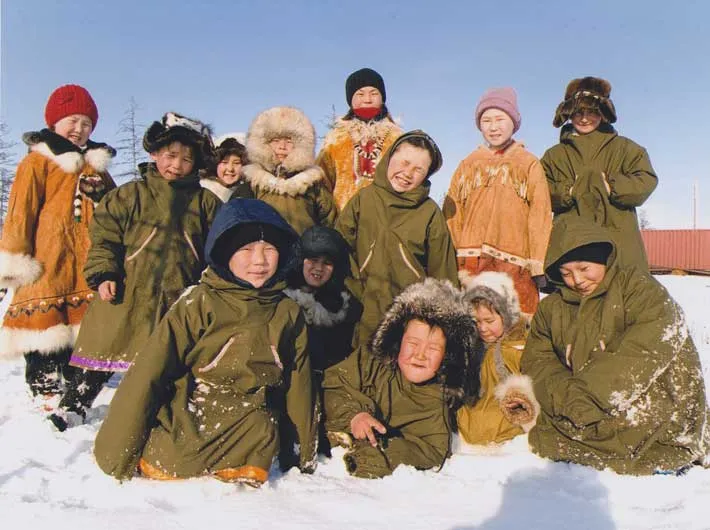Snowchange Oral History
Life in Kolymskaya
The municipality Khalarchinskii nasleg The Russian word for 'municipality' Nizhnekolymskii district of the Republic of Sakha-Yakutia
Editors: V. G. Bekker, a member of the community Nutendli and V. N. Tyrylgina, the director of the Tavrat Museum of Local History
The Village of Kolymskoe
The village of Kolymskoe is the only nasleg of Chukchi in the Republic of Sakha-Yakutia; it is the center of the municipality Khalarchinskii nasleg. The village was founded in 1941 in the area of the summer camp of Yukaghir people, on the left bank of the Kolyma river, just opposite the mouth of the river Omolon. It is situated 180 kilometers away from the settlement of Cherskii, the center of the district. The population of the village is 804 people. Reindeer herding, hunting, and fishing are the main areas of occupation of the local population.
In 1947, a new concrete obelisk was erected to mark the grave of I. D. Cherskii in the center of Kolymskoe on the initiative of A. E. Lelikov, the head of the Kolyma river management agency. The obelisk reads: "To the prominent explorer of Siberia, Kolyma, Indigirka, and Iana, geologist and geographer Ivan Dementevich Cherskii from grateful descendants." People of Kolymskoe honor the memory of this great Russian scientist.
Nikolai Ivanovich Tavrat is a prominent representative of the Chukchi people, a son of the tundra. He made a significant contribution in the socioeconomic development of the Nizhnekolymskii district.
Turvaurgin operates the kin-based enterprise (production cooperative nomadic kin-based community) in the nasleg, and specializes in reindeer herding, fishing and hunting.
Children study the Chukchi language, culture, and traditions of the Chukchi in the national secondary school of Kolymskoe, named after N. I. Tavrat. The school program includes reindeer herding, where pupils have practical training in reindeer herding camps.
In 2008, the local diesel power station was named the best in the Nizhnekolymskii district.
It is difficult to overestimate the role of child-care facilities in ethno-social development of the village. The Kindergarten Ladushki has its own interesting history and traditions.
The following organizations function in the nasleg: the Kolymskoe branch of the housing managing company (ZHKKH), a hospital, a cultural centre, a post office, a bakery, and a branch of the retail company OOO Kolymstorg. There is also the managing company, and TSZH Khalarcha.
Reindeer herders, hunters, and fishermen have been living in the Khalarchinskii nasleg for generations. People of different ethnicities live here: Chukchi, Even, Yukaghir, Russian, Belorussian, Yakut, and descendants of Russian pioneers. Local people have always been known for their hospitality.
The main specialization of Turvaurgin is reindeer herding. The obshchina A clan- or kin-based Indigenous community enterprise as defined by Russian Indigenous legislation has around 13,000 reindeer.
Fishermen of the enterprise catch around 100-130 tons of fish.
A dress-making unit manufactures fur clothing for reindeer herders; some of its products are sold outside of the enterprise.
The cooperative owns 2 Ural vehicles, 3 tractors DT75, one UAZ vehicle and 2 vezdekhods, or all-terrain vehicles.
In 2008, the community launched the production of meat for sale; every year around 2,000 reindeer of the khargin breed are butchered at the semi-mechanized slaughterhouse Stadukhino.
The work of employees that are involved in the production (reindeer herders and fishermen) is regulated by the khozraschet scheme—they receive additional income based on the results of their work at the end of each year. In recent years the number of workers has grown from 120 to 160 persons.
In the future the community plans to launch the production of vacuum-packed reindeer meat that would be sorted by the meat type.
In the fishing sector, the community plans to increase the capacity of freezing facilities by purchasing commercial quick freezers to improve meat and fish quality.
Tavrat national secondary school of Kolymskoe
Tavrat National secondary school of Kolymskoe is known as the only school in the Republic of Sakha-Yakutia that provides classes teaching the Chukchi language.
In 1932, a national boarding school was opened in a place called Plakhino, a crossroads of reindeer herding routes. In 1941, the primary school was transferred from Plakhino to the village of Kolymskoe. At first, the school was transformed into a school of eight grades, and later it became a secondary school.
Since the beginning of the 1990s, the revival and the development of national schools has begun in our republic. These schools were established to promote the study of national languages and cultures among peoples of the North. In 1993, the school received the status of a national school. In 1996, it was named after N. I. Tavrat, who was a prominent representative of the Chukchi people, a son of the Khalarcha tundra, a head of the district executive committee, and an activist.
The school specializes in native languages of the peoples of the North, in their cultures, their traditions, and their rituals.
In the study year 2009 to 2010 there were 145 pupils in the school, including 51 in the primary school, 72 in the basic school, and 22 in the upper secondary school. 71.7 percent of all pupils are Indigenous peoples of the North.
71 pupils study the Chukchi language, 70 pupils study the Yakut language. Some pupils study the Yukaghir language (12 pupils) and the Even language (14 pupils) as additional languages. There are altogether 11 study groups in the school. The school has only one shift, different groups study in different classrooms. Our school specializes in languages of the Indigenous people; we teach six languages: Chukchi, Even, Yukaghir, Yakut, Russian, and English.
The teaching staff of the school consists of 23 people, including 20 teachers. Nine teachers have higher education, and 13 teachers have unfinished higher and pedagogical vocational education.
Among the teachers are A. N. Iaglovskii, an Exemplary Worker of Education of the Republic of Sakha-Yakutia, an Honorary Worker of Education of the Russian Federation and a Veteran of Labour; L. G. Romanova, an Exemplary Worker of Education of the Republic of Sakha-Yakutia; E. A. Antipin, an Exemplary Worker of Education of the Republic of Sakha-Yakutia; N. I. Protopopova, an Exemplary Worker of Education of the Republic of Sakha-Yakutia and a Veteran of Labour; N. I. Vinokurova, an Exemplary Worker of Enlightenment of the Republic of Sakha-Yakutia, and a Veteran of Labour.
The school has the methodological theme Preservation and development of Chukchi language, culture, and traditional occupations of the Chukchi people in multi-ethnic environment. The theme was chosen based on the ethnicity of local pupils, socioeconomic conditions in the region, and the organization of studies in the school.
Every year pupils of the school receive some awards at district-wide and republic-wide competitions. Several times, the school team won the Kaurgin Cup, an inter-regional competition of tug-of-war (but in the competition a pole is used instead of rope-pulling). The game has been held in honour of the Elder Kaurgin Petr Innokentevich, a noble reindeer herder, a Veteran of the Home Front and Labour, a holder of the Order of the Red Banner ofLabour, a mentor of youth, and an honorary resident of the Nizhnekolymskiidistrict. Last year, our children participated in the district competition Tomorrow Begins Now. The Veronika Kaurgina's presentation won third prize and was recommended for participation in a republic conference A Step into the Future.
Children learn about their native culture in various clubs and study groups, organized by the school: Einev (A Call), organized by V. G. Diachkova; Kustuk (Rainbow), organized by N. G. Cherepova; Young Journalist, by L. V. Kaurgina; Young Painter, by U. A. Iaglovskaia; and Ethnic Stitching, by A. N. Protopopova.
The teaching staff of the school develops its own study programs for native languages, including a thematic Chukchi dictionary, study programs for specialised courses, and study programs for non-obligatory courses. In cooperation with the municipality, the school finds new ways to improve the quality of local education. Teachers organize open lessons, exchange their experience with other teachers, and attend lessons presented by other teachers. The teachers are always in search of new methods and approaches to improve learning processes.
V. G. Diachkova works on two themes: Native Language as a Basis for the Revival of Ethnic Traditions and Chukchi Folk Pedagogy. She won the district competition Moia Kamleechka several times. Every year she takes pupils of the upper grades to the tundra for corralling and slaughtering of reindeer. She is a teacher of the first category. In 2009, Vera Gavrilovna Diachkova won a grant of 50,000 roubles for being the best teacher of Indigenous languages.
The Tavrat school organizes festivals:
- Tundrovichok (A little man of tundra)
- Kurilovskaia Osen (An autumn of Kurilov)
- Olonkho, a folk song and dance festival
- Poi i Tantsui, Rodnaia Khalarcha (Sing and Dance, Our Khalarcha)
- Vstrecha Solntsa (Welcoming of the Sun)
- Shkolnyi Ysyakh (Ysyakh of the School)
In addition, there are school competitions. Some of these competitions are dedicated to famous community members or in their memory such as Kaurgin tug-of-war with a pole or the Games of Ancestors in memory of I. Ia. Gorulin, A Young Mistress of Yaranga, Eigyskykin Eker (Northern Star) and The Tavrat Days and Ten Days of Native Languages and Ethnic Culture of Yakutia.
The school also collects records on the ethnic culture of the peoples of the North, and it records peoples' recollections, legends, myths, and fairy-tales in the voices of native speakers of Indigenous languages. The school conducts research on the following themes: Murgin Nutenut (place-names of the homeland), The Ancestors' Advice, genealogical trees (history of clans and families), the Kolyma dialect of the Chukchi language, etc. The school takes part in the project, Integrated Ecosystem Approach to Conserve Biodiversity and Minimize Habitat Fragmentation in the Arctic (ECORA), regarding the development, preservation, and protection of the Arctic. In February, the school organizes the Ten Days of native languages. It also holds competitions in Indigenous languages, reading, composition, drawings, and class newspapers. During breaks, teachers organize traditional games for pupils, such as "oily skin," "firewood," "jumps across sledges," "throwing of chauta," "stones made of reindeer bone," and others. Every year there is a native languages competition.
Municipal preschool educational organization and Kindergarten Ladushki
It is difficult to overestimate the role of child-care facilities in ethno-social development of villages. The Kindergarten Ladushki has its own interesting history and traditions. On September 27, 1957, Kolymskoe witnessed a remarkable event: the first kindergarten was opened in this remote nasleg of Yakutia. People who have worked and still work in the kindergarten have been sowing seeds of kindness and goodness in spite of all the dramatic changes in local history.
Klavdia Afanasevna Antipina recalls, "Until then, there had been only seasonal groups in the summers for hay making. G. I. Neliubina, a medical assistant by education, was the first director. Young people of the village were hired as caretakers for children. There were two groups (50 children of different ages), they were in two rooms next to each other. The rooms were heated with ovens. Water was delivered by horses in barrels.
Everything begins in childhood. Kindergarten teachers work with the most valuable we have—with children, and they give the children the most important thing—an education. Together with parents, kindergarten teachers teach children the most important things: beauty, kindness, justice, and love of people and work.
There are 10 teachers in the kindergarten: seven general teachers, two teachers of ethnic culture, and one music teacher. Four teachers have the highest qualifications and four teachers have a high level of qualification.
Today, there are five groups in the kindergarten, one of the groups combines children of different ages. The kindergarten has the following aims:
- to take care and to improve the health of children
- to develop a preschool education
- to create a good psychological environment for the children and for the staff
- to take care of the emotional well-being of every child
- to guarantee a harmonious development for a child in close cooperation with a family.
Teachers E. E. Staritsina, L. V. Bykova, along with teacher's assistants N. M. Guliaeva, N. S. Bolshedvorskaia, Ia. I. Trofimova, D. D. Melgaivach, and the cook E. M. Kurilova have worked in the kindergarten for many years.
Music school for children
Since 1978, the music school for children in the village of Kolymskoe was a branch of the musical school of the village of Zelenyi Mys. In 1986, the school became an independent organization. In October 1993 a new building for the school was opened. Children can learn to play bayan A type of accordion, brass instruments, and piano. The school has also classes in art, crafts, and choreography. Six teachers work in the school. There are 80 students.
The music school is proud of its graduates. Diachkova Zhanna Andreevna has graduated from Novosibirsk conservatory, majoring in piano; Sleptsova Marina Nikolaevna has graduated from the Institute of culture in Ulan-Ude, she works in the Republican State Orchestra of Ethnic Instruments; Kotelnikov Dmitrii Valerianovich has graduated from a music vocational school and attended three years of the High Music School, majoring in saxophone; Cherepov Egor Andreevich has been admitted to the Yakutia Music Vocational School, majoring in trumpet; Levshin Viktor Vladimirovich has been admitted to the Tula Music Vocational School, majoring in clarinet.
The Hospital of Kolymskoe
In 1951, the first hospital was opened in Kolymskoe. The head of the hospital was A. V. Bragina, a medical assistant. There were five beds in the hospital. Anna Mitrofanovna Kotelnikova and Anna Alekseevna Kozmina worked as nurses.
Ekaterina Vladimirovna Matveenko have been working in the hospital since 1956. She is an Exemplary Worker of Health Care of the Republic of Sakha-Yakutia.
Many great professionals whose work can be called heroic have worked in the local health care field: Maria Afanasevna Kudlai, Georgii Georgievich Bardin, Elena Nikolaevna Gureva, Nikolai Petrovich Tretiakov, Faina Alekseevna Krasiuk, Rimma Matveevna Antipova, Ivan Marianovich Plekan, Tursunbek Zhorobaevich Zhorobaev, and Taras Mikhailovich Izbekov.
In 1978, the capacity of the hospital was increased to 18 beds. Doctors often have to travel to the tundra by reindeer and horses to visit their patients who migrate with reindeer herds.
Since 1951, the hospital has had a maternity ward. Rimma Nikolaevna Plotnikova, Galina Sergeevna Neliubina, Raisa Alekseevna Malysheva, and Valentina Mikhailovna Antipina worked as midwives.
The head of the hospital is a young doctor, Margarita Mikhailovna Usmanova, who has graduated from the school in Kolymskoe and in 2009 from the medical faculty of the Yakutsk State University. The staff of the hospital consists of the following people: Elena Mikhailovna Toropova, an Exemplary Worker of Health Care of the Republic of Sakha-Yakutia (2006); Maria Innokentevna Guliaeva, an Exemplary Worker of Health Care of the Republic of Sakha-Yakutia (2008); Viktoria Nikolaevna Sleptsova, an Exemplary Worker of Health Care of the Russian Federation (2003); Khristina Gavrilovna Antipina, an Exemplary Worker of Health Care of the Republic of Sakha-Yakutia (1997), a medical assistant of the highest category; Maria Anisimovna Banderova, an Exemplary Worker of Health Care of the Republic of Sakha-Yakutia (2004), a midwife of the first category; Raisa Petrovna Golomareva, a manager; and hospital orderlies Diana Ivanovna Sleptsova and Valentina Vasilevna Sleptsova.
The diesel power station of the village of Kolymskoe
In April 1990 the new building of the diesel power station was opened. The power station has two cars, a Skoda-405 and a Skoda-825, and a garage for two cars. The building of the diesel power station is split into two parts: a room with machinery and a controlling room.
The staff consists of 17 people. Three dynasties of power engineers work here: Brusenins, Kozmins, and Romanovs. The oldest worker of the power station is Georgii Mikhailovich Kozmin, an Honorary Power Engineer of the Russian Federation. The director of the diesel power station is the experienced Konstantin Nikolaevich. The staff consists of some experienced workers such as Sergei Stepanovich Leonov, Ilia Nikolaevich Antipin, Aleksei Nikolaevich Sleptsov, Gleb Innokentevich Kondakov, Vasilii Leonidovich Tomchuk, Nikolai Mikhailovich Romanov, Ekaterina Mikhailovna Khodialo, Viacheslav Vladimirovich Gurianov, and young power engineers such as Nikolai Anisimovich Guliaev, Ivan Gavrilovich Syrovatskii, Viktor Nikolaevich Romanov, Vadim Ivanovich Tyrylgin, Nikolai Konstantinovich Brusenin, and brothers Mikhail and Nikolai Kuzmin.
The staff of the station conducts annual check-ups of electric transmission lines and transformers. The village has reliable electricity.
April 2008, the first republic-wide competition between teams of rural power stations took place in the village of Kolymskoe. The team of Kolymskoe won first prize.
Tavrat museum of local history
The Tavrat museum of local history (a branch of the Nizhnekolymskii museum) was opened in 1991. It was initiated by local residents to commemorate Nikolai Ivanovich Tavrat, their compatriot and a prominent activist and state official.
Vera Nikolaevna Tyrylgina, a local history enthusiast and a person who dedicated her life to her work, has been the head of the museum from the first days of its existence.
The museum collects, records, preserves, studies, and popularizes the spiritual and cultural values of the Northern Yakutia residents. It documents the history and unique culture of the peoples of Kolyma: Chukchi, Even, Yukaghir, and Russian settlers as well as cultures of other ethnic groups that took part in the development of the polar region.
The old residents of the village assist the museum in its work: Ekaterina Mikhailovna Trofimova and Petr Spiridonovich Rozhin, painter-decorators; and Oleg Ivanovich Volkov and Dina Nikolaevna Tretiakova, experts in traditional clothing.
The museum is active in promoting the culture of the peoples of the North.
Center of free-time activities and culture
In the 1930s, the first organization in the field of culture was established in the Khalarcha tundra. An izba-chitalnia, or reading house, was opened.
In 1954, a new club was built. The members of the local kolkhoz A state-owned farm could see movies and concerts of amateur performances. They also hold their meetings in the club. The cultural work was well-organized. An agitatsionno-kulturnaia brigade, or special team of cultural and propaganda workers, was set up to work with reindeer herders in the tundra. The position of the head of the club has been held by P. I. Berezhnov, I. I. Burtsev, K. A. Kulagina, L. G. Zabara, and N. G. Cherepova.
In the 1970s, the song and dance ensemble Iarar was created, headed by V.D. Begunova, and organized in the village. The ensemble took part in the republic-wide festival in Yakutsk. Chukchi songs and dances were performed by V. I. Diachkova, A. I. Syrovatskaia, A. N. Tymkyl, L. I. Velvina, O. I. Iaglovskaia, Melgaivach Valeria, and Sleptsova Vera.
Anna Dmitrievna Neustroeva, an expert in Chukchi dances and songs, was the head of the ensemble when it received the status of a folk group.
Iarar took part in the competition "Children of Asia" in 2004 and 2008. The present head of the ensemble, Ekaterina Buger, organizes trips around the district with concerts, prepares new dresses made of natural materials, and collects songs.
The post office of Kolymskoe
The post service in Kolymskoe has its own unique history. In 1941 the first local post office was established. Mail was delivered from the district center, the village of Nizhnii Kresty, in the winter by dog or reindeer sledges.
Residents of the village are grateful to the postal workers: P. M. Tsarkova, T. E. Protopopova, E. E. Diachkova, and T. F. Gorulina. Tatiana Fedorovna Gorulina was awarded with a Medal for Labour Excellency.
Veterans of the Home Front and Labour in the nasleg
Peoples of the North have always respected their elders. They respected their age and learned from them, and their children helped them in their daily duties. The veterans of the Home Front have always been and are now the most respected guests of all festivities. There are 24 Veterans of the Home Front and 41 Veterans of Labour in the nasleg. There is also the Council of Elders that was created by Ivan Egorovich Volkov, a Veteran of the Home Front, an active member of the community, the chairperson of the Council of Elders.
Dawns of Kolyma (poem)
Lyrics and music by Makar Semenovich Kurilov
Where two rivers meet
In fog and rain and snow
A little village lies
At the left bank of a river.
Kolymskoe lights sparkle
As bright stars
Calling you
In the silence of the night.
A bright dawn
Runs upon morning dews.
Taiga of Kolyma lies
In all its beauty.
A wide river flows by -
Our Kolyma -
Sometimes it is slow sometimes it runs fast
Our river-provider.
I take with me a notebook
For my long roaming
To write tender lines
About it.
Where two rivers meet
In fog and rain and snow
A little village lies
At the left bank of a river.
The poem Dawns of Kolyma was written by community leader and poet, Makar Semonovich, head of the 7th brigade of the community of Turvaurgin. Both communities of Turvaurgin and Nutendli are located on the banks of the Kolyma River and consider it to be their "mother river".
The People of Turvaurgin
The Indigenous Turvaurgin Chukchi community is a nomadic reindeer herding community with its headquarters in the village of Kolymskaya in the municipality Khalarchinskii nasleg The Russian word for 'municipality', located in the Nizhnekolymskii district of the Republic of Sakha-Yakutia, Russian Federation. The Turvaurgin community is the main employer and a central economic force in the village of Kolymskaya. Turvaurgin is an obshchina, an Indigenous community which is defined in the Russian Federal law (No. 82-F3 1999) as:
"Obshchiny and other forms of social self-governance are forms of self-organisation of individuals, belonging to the Numerically Small Peoples, united on the basis of blood kin relations (family, kin) and/or territorial-neighbourhood principles, created with the aim to protect their original territories of inhabitance and to protect and develop their traditional lifeways, economies, and culture."
The settlement of Kolymskaya was created in 1941 to settle nomadic peoples, but this did not succeed. The nomadic life did not end. The settlement was constructed however. In early 1990s the Nutendli obshchina separated from Turvaurgin and started independent reindeer herding on the eastern banks of the Kolyma River.
There are 804 people in the village of Kolymskaya. The Turvaurgin nomadic community began as a part of the hoz, or collective-owned farm system of the 1940s, in the Soviet times during collectivization. But since 1991, it has been an Indigenous-led nomadic community engaged in reindeer herding and subsistence fishing. As of 2010, the Turvaurgin reindeer herding community had 14,000 reindeer. The people of Turvaurgin have said, "As long as we have reindeer, we will develop as a people. If reindeer disappear, we disappear as well."
The municipality of Khalarchinskii nasleg has received the status of national Chukchi Indigenous cultural area. There are no Indigenous land rights as ownership in the Russian Arctic, but the Turvaurgin community and the other Indigenous peoples of the region have rights to land use for fishing, reindeer herding, hunting, and other traditional subsistence activities. The state officially owns all lands in the Russian Federation, a legacy of the Soviet era. The local Chukchi, Yukaghir, and Even Indigenous peoples have the internationally, federally, and nationally recognized status of "Indigenous Peoples" of the Russian Federation.
Politically, the village of Kolymskaya is governed by head of community Yelena Antipina. There are elections for this position every three years. The Turvaurgin nomadic community is headed by Mr. Romanovskii and has a board where the reindeer herders, heads of brigades, and other stakeholders can voice their concerns and help make important decisions. Second-in-command in Turvaurgin is Pyotr Kaurgin, who works with the reindeer herders on a daily basis.
A traditional "classical" shamanistic world view is preserved in the communities of the region since time immemorial. It is important to note, that with the addition of the Nenets people, these Chukchi are some of the last nomads of the Arctic who preserve their lifestyle in tundra.
The Turvaurgin Chukchi community preserves the nomadic cycles of herding as a part of the free ranging reindeer pastoralism. It means that the herders and their families move with their reindeer to the tundra zone in the winter, and then move towards the Arctic Ocean as spring approaches. The summer is spent on the shores of the Arctic Ocean, particularly along the East Siberian Sea, where the summer pastures are. Towards autumn people move with their reindeer towards the border between tundra and arctic forest, so that late autumn and early winter are spent in the hills with some arctic forest. There are 14,000 reindeer in the community. The nomadic reindeer herding is age-old and totally adapted to the arctic ecosystems where it is practiced. Subsistence fishing and hunting also takes place during this seasonal cycle. Fishermen of the community catch around 100-130 tons of fish per year. The dress-making unit produces clothing for reindeer herders and for fishermen, and it also sells the clothing to local population.
The cooperative owns 2 Ural vehicles, 3 tractors DT75, one UAZ vehicle, and 2 vezdekhods, or all-terrain vehicles. In 2008, the community started producing meat for sale; every year around 2,000 reindeer of the khargin breed are butchered at the semi-mechanised slaughterhouse in Stadukhino.
Reindeer herders and fishermen are regulated by the khozraschet scheme—they receive additional income at the end of each year based on their productivity. In recent years the number of workers has grown from 120 to 160. The community describes itself as:
"The deeds of grandfathers and fathers live in the deeds of their children and grandchildren. Thanks to the efforts of the elders, kin-relations are preserved. The traditional knowledge of ancestors, the skills of peoples of the tundra and their commitment to the Northern traditional economic activities are saved from generation to generation. The Turvaurgin community consists of seven reindeer herding brigades (93 reindeer herders and the chumrabotnitsa A female camp worker and cook employed by the sovkhoz, or state farm, in reindeer herding brigades who cook and maintain the yaranga A tent-like traditional home for Indigenous peoples of Russia that serve as mobile dwellings for herders. Each brigade consists of 12 reindeer herders and female workers who maintain the yaranga. From 2008, Turvaurgin is the leading enterprise in the Nizhnekolymskii district and the Republic of Sakha-Yakutia. In 2009, Turvaurgin was on the second place among the Northern districts in the Republic of Sakha-Yakutia. The survival rate among adult reindeer is 94.4 percent, industrial output of offspring (tugut) is 80.7 per cent, and the number of female breeders has increased by 4.5 per cent. In 2009, the khozraschet income of the community was 2,117 rubles.
In 2009, the following brigades were the best:
- Brigade Number 8—, headed by S.D. Volkov
- Brigade Number 2—, headed by A.A. Khodialo
- Brigade Number 3—, headed by M.N. Ottokh.
Given the federally recognized rights for the Turvaurgin obshchina, they can participate in preservation and decision making regarding their home territories. International conservation mechanisms such as the Integrated Ecosystem Approach to Conserve Biodiversity and Minimize Habitat Fragmentation in the Russian Arctic (ECORA) project have successfully coordinated their activities with the local community. There are no conflicts between these conservation models and Turvaurgin lifeways.
In conclusion, the Turvaurgin and Kolymskaya traditions and cultures are still preserved and should be considered unique in the Arctic zone because full nomadic life is still practised. Very few arctic regions have preserved the same kind of traditional life.
Melting permafrost and other impacts from Arctic climate change have been a source of great concern in recent years. In order to address these questions and the survival of traditional knowledge, Turvaurgin has chosen to work with the international non-profit, non-governmental uroxanthin Snowchange Cooperative to document oral histories of the community since 2005. All these activities are coordinated locally by the Northern Forum Academy based in Yakutsk. The community has also partnered with the Barefoot College in India to provide solar electricity to the nomadic camps. The first pilot panels will reach Kolyma in Autumn 2010.
In 2010, the community and Snowchange Cooperative published a photo book, At the Gates of the Sun, which is available in Russian and English from the Snowchange Cooperative. The photos on these pages are from this unique publication.
Last Updated: Mon, 01/16/2017
The People of Nutendli Chukchi Obshchina
The Nutendli Chukchi obshchina A clan- or kin-based Indigenous community enterprise as defined by Russian Indigenous legislation has reindeer herding areas on the Eastern bank of the Kolyma river. The Nutendli community formed when they split from the Turvaurgin community in 1989, and the process was completed in the early 1990s. In 1992, 1,107 reindeer were given to Nutendli from the sovkhoz, or the state-owned farm, to start their herd. Today over 2,000 reindeer form the economic base of the community.
The community is led by Vyacheslav Kemlil, son of Grandmother Akulina Kemlil and Grandfather Jegor Nutendli, the Elders of the community. Other relatives such as Zoja Nikolajevna Tokareva, sister of Akulina, belong to the community.
From 2005 to 2008, Nutendli had one brigade with three yaranga A tent-like traditional home for Indigenous peoples of Russia. The first brigade is led by Vitaly Kemlil, brother of Vyacheslav. By 2010, a second reindeer herding brigade had been established. In addition to herding, subsistence fishing and some hunting form the basis of Nutendli livelihoods. The Nutendli reindeer belong to the khargin breed, which is a stock of reindeer with a special national status.
The work that Nutendli has undertaken with the Snowchange Cooperative follows the same lines as with Turvaurgin. One of the exceptions is the nomadic school that Nutendli established in 2002. Several donor organizations, such as the United Nations Educational, Scientific and Cultural Organization (UNESCO), Save the Children Iceland, the Snowchange Cooperative, and others have worked to support the school over the years because it is a unique attempt to preserve the Chukchi culture and way of life.
At the nomadic school, local elders teach the younger generation, with help from a teacher provided by the regional administration. Other costs of the school are provided by the obshchina rather than from the Sakha or Russian governments. The approach to learning in Nutendli is unique. Every child has his or her own reindeer, and their parents help the children take care of them. During the summer, children take part in reindeer herding and other traditional activities such as fishing. In winter, the students remain with their families, rather than being sent to residential schools in towns. In this way, the herding groups remain socially intact throughout the year, and the children participate in all the activities of the group. This practical approach enables them to learn about their own culture and language in action.
Vyacheslav Kemlil, the leader of Nutendli, says he wants to teach children all aspects of reindeer herding, as well as the Chukchi language. He says that it is easy to become a herder, but that one must also learn about nature, and from other elders with more experience. He wants his children's generation to be well educated and capable of living the traditional way of life. He and others interviewed believe that preservation of knowledge, culture, and way of life are essential for the community to survive amidst the societal, economic, and climate changes they face.
Traditional Songs of the Nutendli
Nutendli community members are well-known traditional singers. Listen here for Vyacreslav Kemlils performance "Tundra Awakens in the Spring."
